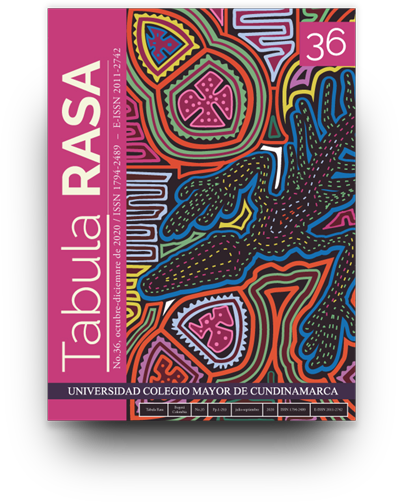Intercambios entre humanos y árboles en el área istmo-colombiana. Aportaciones etnográficas desde Gunayala (Panamá)
Exchanges Between Humans and Trees in the Isthmo-Colombian Area: Ethnographic Contributions from Gunayala (Panama)
Mostrar biografía de los autores
Las relaciones que se establecen entre colectivos humanos y vegetales ha sido un aspecto poco explorado por la etnografía del área istmo-colombiana. En este artículo, a partir de una experiencia etnográfica de más de veinte años entre los gunas de Panamá, se analizan los modos de relación entre humanos, árboles y seres subjetivizados que provienen de éstos últimos, los llamados nudsugana: tallas antropomorfas y zoomorfas de madera que albergan vida. Después de explicitar que el caso de estudio será analizado desde una perspectiva ontológica, se describen tres elementos: a) el lugar que ocupan los árboles en la creación del mundo guna, b) su función en los procesos de curación y c) la co-residencia de los nudsugana. En las conclusiones se analizan las relaciones de interdependencia entre humanos y árboles, mostrando que sus vidas, a pesar de estar entrelazadas, obedecen a lógicas de sujeción y se enmarcan en una simbiosis jerárquica.
Visitas del artículo 141 | Visitas PDF 100
Descargas
- Albert, B. (2016). La forêt polyglotte = The polyglot forest. En: Le grand orchestre des animaux = The great animal orchestra, (pp. 91-99). Paris: Fondation Cartier pour l’Art Contemporain.
- Albert, B. (2019). Nous les arbres. Paris: Fondation Cartier.
- Albert, B. & Kopenawa, D. (2010). La chute du ciel. Paroles d’un chaman yanomami. Paris: Plon.
- Chapin, M. (1983). Curing among the San Blas Kuna of Panamá. Doctoral thesis. University of Arizona, Tucson.
- Chapin, M. (1989). Pab Igala. Historias de la tradición kuna. Quito: Abya-Yala.
- Descola, P. (2005). Par-delà nature et culture. Paris: Editions Gallimard.
- Descola, P. (2014). All too human (still) A comment on Eduardo Kohn’s How forests think. Hau: Journal of Ethnographic Theory, 4(2), 267-273. https://doi.org/10.14318/hau4.2.015
- Fortis, P. (2012). Kuna art and shamanism: an ethnographic approach. Austin: University of Texas Press.
- Gudeman, S. (2019). L’énergie vitale. Le courant des relations. Bérose Encyclopédie internationale des histoires de l’anthropologie, Paris. http://www.berose.fr/article1753.html?lang=fr
- Halbmayer, E. (2020). Introduction. Toward an anthropological understanding of the area between the Andes, Mesoamerica, and the Amazon. En E. Halbmayer. (Ed.). Amerindian Socio-Cosmologies between the Andes, Amazonia and Mesoamerica. Toward an Anthropological Understanding of the Isthmo–Colombian Area, (pp.3-34). London: Routledge.
- Holmer, N.M. & Wassén, S.H. (1963). Dos cantos shamanísticos de los indios cunas. Etnologiska studier, 27. Göteborg: Etnografiska Museet.
- Howe, J. (1986). The Kuna Gathering. Contemporary Village Politics in Panama. Austin: University of Texas Press.
- Kaviany, S. (2020). Plant ontologies among the Bribri of Talamanca, Costa Rica. En E. Halbmayer (Ed.). Amerindian Socio-Cosmologies between the Andes, Amazonia and Mesoamerica. Toward an Anthropological Understanding of the Isthmo–Colombian Area, (pp.279-302). London: Routledge.
- Kohn, E. (2013). How forests think: Toward an anthropology beyond the human. Berkeley: University of California Press.
- Mancuso, S. & Viola, A. (2018). L’Intelligence des plantes. Paris: Albin Michel.
- Martínez Mauri, M. (2020). Things, life, and humans in Guna Yala (Panama): talking about molagana and nudsugana inside and outside Guna society. En E. Halbmayer (Ed.). Amerindian Socio-Cosmologies between the Andes, Amazonia and Mesoamerica. Toward an Anthropological Understanding of the Isthmo–Colombian Area, (pp.257-278). London: Routledge.
- Niño Vargas, J.C. (2020). An Amerindian humanism: order and transformation in Chibchan universes. En E. Halbmayer (Ed.). Amerindian Socio-Cosmologies between the Andes, Amazonia and Mesoamerica. Toward an Anthropological Understanding of the Isthmo–Colombian Area (pp.37-60). London: Routledge.
- Nordenskiöld, E. & Pérez Kantule, R. (1938). An historical and ethnological survey of the cuna indians. Comparative Ethnological Studies, 10. Göteborg: Gotebörgs Museum.
- Perrin, M. (2007). Réveiller les figurines. Les nuchu des Indiens kuna. En M. Perrin, Voir les yeux fermés. Arts, chamanismes et thérapies, (pp.89-105). Paris: Le Seuil.
- Rival, L. (1998) The Social Life of Trees: Anthropological Perspectives on Tree Symbolism. New York: Berg Publishers.
- Shiratori, K. (2019). O olhar envenenado: a perspectiva das plantas e o xamanismo vegetal jamamadi (médio purus, am), Mana, 25(1), 159-188. http://dx.doi.org/10.1590/1678-49442019v25n1p159
- Wagua, A. (2000). En defensa de la vida y su armonía. Elementos de la religión kuna. Textos del Bab Igala. Congreso General Guna, Emisky/Pastoral Social-Cáritas, Panamá.
- Wohlleben, P. (2016). The hidden life of trees. Vancouver: Greystone Books.








